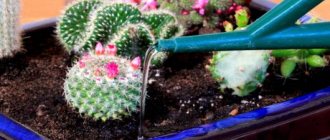Features and rules for watering cactus
Regardless of the purpose for which you bought a cactus - growing a large number, decorating a windowsill with a couple of flowerpots, or as a gift to a loved one - you need to remember the rules of care and watering. It is a competent strategy and systematic approach that will ensure active growth, flowering and the appearance of new shoots for further replanting.
Cacti on the windowsill
It is necessary to be especially careful when watering succulents of flowering varieties, since a lack or excess of moisture can negatively affect the timely appearance of a healthy bud.
When choosing succulents as a home plant, you should not take them lightly and turn a blind eye to the rules of watering. Using the wrong water, excess fertilizer or incorrect watering techniques can cause the plant to die in a short time.
How often to water
The frequency of watering a home cactus directly depends on many factors. The most important of them are described below.
Plant type
Astrophytum cactus: options for different types and examples of care at home
The seller must tell you about this and also provide instructions for caring for a specific variety. For example, if the future pet was brought from the desert, it will not be too whimsical and water-loving. Such plants need minimal irrigation once a week or a week and a half, and even then only in the hot summer.
Important! Succulents brought from the tropics love high humidity, so they need more frequent watering in both winter and summer.
There is nothing simpler than instructions on how to water Decembrist or prickly pear - they are not afraid of water in any quantity. Mammillaria is the same unpretentious plant.
Succulent placement
If you place a plant at home on a window located on the sunny side, or next to a powerful battery, heater, computer or laptop ventilation, it will require more moisture. In cooler and less lit areas, water less often and less frequently.
Pot material
Even such a minor detail affects the frequency. Ceramic and clay pots slightly promote moisture absorption, so more frequent and intense watering will be needed. There are much fewer problems with plastic and glass dishes.
Age of cactus
If the plant is very young, it spends more nutrients from water and substrate for its development and flowering. Therefore, it needs more moisture than its older brothers.
Different types of cactus need different frequency of watering
Life cycle
When the plant begins its growing season, that is, it actively begins to grow, and the ovary appears in flowering varieties, you need to prepare for frequent watering. This is usually the period from late spring to late autumn.
Due to the relocation of a succulent to a different environment, its natural cycle may be disrupted, and the growing season begins in winter. The change in behavior must be carefully monitored so as not to leave the plant without moisture, which is vital at this time.
Substrate condition
This is a separate and very important issue when growing a healthy and strong cactus, since most of the so-called universal store-bought substrates actually contain a lot of components that are dangerous to the plant. Sometimes the quality of the soil simply leaves much to be desired: a solid mass of peat does not deliver water to the roots, and a lot of loose sand or clay, on the contrary, leads to their rotting.
Attention! Watering the cactus and its frequency also depends on the quality of the water and the additives in it. It may be necessary to observe the moisture absorption and condition of the succulent for some time to determine the optimal frequency.
How to water representatives of different species?
As already noted, tropical forest plants need water more than their desert counterparts. They are epiphytes and attach to larger specimens, but do not feed at their expense. Thanks to their aerial roots, these cacti are able to extract moisture even from the air. Desert inhabitants are accustomed to a different climate and are much more drought-resistant.
Tropical cacti
They favor spraying; moreover, in hot weather or dry air due to the operation of heating devices, it is recommended to irrigate them periodically. But they tolerate complete drying out of the soil very poorly.
How often should you water certain forest cacti at home, depending on the type? It is worth considering the most common varieties.
Rhipsalidopsis - it is also called the “Easter bush”. From the beginning of spring to September, this succulent is watered once every week and a half, in winter - once every 3-5 days. It is worth considering that during flowering the substrate in the pot with ripsalidopsis should be constantly slightly moist.
Schlumbergera (Decembrist, Christmas cactus or Varvarina spit) - moisture is added every 3-5 days from June to September, the same regime is maintained during its flowering. From October until the start of flowering, the succulent is watered weekly, the rest of the time - a couple of times a month.
Pereskia - in the spring-summer period, when watering a flower, you should focus on the condition of the top layer of soil. Moisture is added when it dries. In autumn, the number of waterings is gradually reduced to once every 4-5 weeks and the regime is maintained throughout the winter.
Epiphyllum (previously these succulents were called phyllocacti) - from mid-November to March, gentle watering is recommended - once every 2 weeks. This is done more often in spring and summer, when the soil becomes dry to the touch, but still contains some moisture.
These are just a few representatives of a huge group of epiphytic succulents that are successfully adapted to living indoors. And how many times such cacti need to be watered is related to their needs in a particular season or life cycle.
Desert cacti
The sparse desert landscape, where golden sands stretch for many kilometers, is a frequent decoration of these persistent, rugged plants. In fact, not all cacti look like impressive columns with spines; among them there are very small specimens and even varieties that lack thorns and other means of protection. But, regardless of appearance and size, they are all accustomed to droughts and the scorching sun. Similar “flowers” are also found in rocky, dry areas.
So how often should you water such resilient and unpretentious cacti? As it turns out, giving them “durability tests” at home and leaving them without water for a long time is not recommended at all. And also you can’t water them like other domestic plants.
Acryocarpus - this peculiar star without spines requires a minimum of moisture. Even during active growing season - in spring it is enough to water it once every 3 weeks, when the soil is completely dry. In summer, one watering is enough, and in winter, the flower does without these procedures. Do not allow water to get on the leaves of the succulent; spraying it is also contraindicated.
Cephalocereus and Echinopsis - these cacti, common in home floriculture, are not watered in winter; during the growing season, one watering per week is enough for them.
Gymnocalyciums - like the previous type of cacti, these little hedgehog balls should not be watered in winter. In the spring-summer period, moisture is added once every 1-1.5 weeks, in the fall and even less often - monthly.
It's a parody - from late spring to early autumn, these flowering succulents need one watering every 1.5-2 weeks, in autumn and winter - per month.
Prickly Pear – This popular cactus also doesn’t need much moisture. Starting from spring and until mid-October, it is enough to water the soil once every 4 weeks; in winter it does without watering at all.
It is recommended to wipe the leaves of desert succulents with a damp cloth to remove dirt and dust, but if it is covered with lint, then it is better to avoid this procedure. In this case, you can follow the advice of experienced cactus growers - blow on the “fluffy” pets with a hairdryer using the cold air mode.
Undoubtedly, the watering regime is extremely important when caring for any indoor vegetation. But it is equally important to use suitable water for these purposes.
What water to water a cactus
Ideally clean water in the modern world, especially in megacities, is a legend. Most houseplants adapt over time and respond well to regular tap water. But succulents, due to the characteristics of their origin, react painfully to poor chemical composition of water. How can you improve performance and make the watering process easier?
How to water aloe: frequency and options at home
The best way is to use collected rain or melt water. But this option requires too much effort and patience, so it is not suitable for everyone. A simpler idea is to boil and cool water to reduce its hardness and pH level. This way you can avoid alkalization of the soil and the negative effect of water on the root system when watering cacti.
Note! If you don’t have any time to manipulate water, you can use regular household filters or fill a container and let it sit for 2-3 days before watering.
To improve the quality of water and fertilizing, you can use the following means:
- oxalic or nitric acid (don’t forget to let it settle and drain off the sediment);
- succinic acid (only a one percent solution is suitable);
- diluted peat;
- vinegar 9% (no more than a teaspoon per five-liter container).
Classification of cacti
Cacti vary in appearance, so it is sometimes difficult to determine their relationship to the Cactus family. All species are divided into 4 subfamilies, little similar to each other:
- Pereskiaceae - cacti with leaves. This includes only the Pereskia genus, which has 17 varieties. They have spines and areola growth points, while they are located on the flowers. New shoots and flowers are formed from them. This only happens in cacti. Pereskiev fruits can be eaten.
- Opuntiaceae, which have spines and glochidia (spines pointed in the shape of a harpoon), are shrubs with strong, succulent stems. Almost all of them consist of segments, strongly or weakly expressed. Young plants have leaves. They die off with age. Wood in its homeland, Mexico, is widely used for making furniture. The fruits of most varieties are edible.
- Maihueniaceae are similar in appearance to Opuntiaceae, but without glochidia. They have conical leaves about 1 mm long. Practically not grown at home.
- Cactaceae, which include 80% of all cacti. They have no leaves or glochidia at all. Leaves replace thorns. The stems, with rare exceptions, are whole and have no division into parts. The flowers are open for only one day, and in some varieties - only one night. Some of the plants of this subfamily are edible; they are eaten baked; some have edible fruits.
All cacti are divided into several types according to their growing conditions. Each of them has its own growing characteristics. When buying a cactus, you need to correctly identify its type in order to know how to care for it. Cacti can be divided into the following groups:
- Wet forests. These are zygocacti, epiphyllums, phyllocacti. Plants love diffused light. Therefore, they are grown on eastern and northern windows. They do not like the earthen clod to dry out; the substrate must always be moist. In winter, they need to lower the temperature to 12-15°C and reduce daylight hours.
- Dry forests and grassy plains. In the morning and evening they require sun; at lunchtime they need shade. Windows facing west or east are best suited for growing them. In winter, plants need temperatures up to 10°C, watering 1-2 times a month.
- Desert cacti are installed on windows facing south. They overwinter at temperatures no higher than 10°C. Water at this time once a month.
- Mountain cacti, which include rebutia, lobivia, and oreocereus. Their roots are delicate and easily wounded and do not tolerate waterlogging of the soil. In winter, the temperature should be no higher than 8°C, watering no more than once a month.
Water temperature
How to replant a cactus: options at home
Everything here is relatively simple: under no circumstances should you water succulents with cold water. It should be room temperature, and ideally a little warmer than the air temperature. Cold and excess moisture are the two main enemies of your plant; cacti get sick and die from them.
In healthy cacti, the soil is always slightly dry
Growing cacti
The purchased cactus cannot be immediately installed on the window along with others. First, he must be quarantined for up to two months. During this time, you need to determine whether the cactus is infected with any diseases or pests. It’s even better to transplant it into a new container, treating it with fungicides for prevention.
Features of growing cacti at home:
- In summer, the cactus grows at temperatures up to 24°C. In winter, most species need a drop in temperature. If you keep them at temperatures above 20°C, they will not bloom.
- Cacti need a lot of light. If there is not enough of it, the top of the trunk becomes elongated and the plant loses its attractiveness.
- In summer, cacti can be taken outside. You just need to take into account that they are very afraid of drafts. Plants should be protected from rain and wind with film. First, the cacti are taken out for several hours. Gradually increase the time spent outside. After a couple of weeks they can be left overnight. Temperature changes at different times of the day harden the cactus, its spines become shiny. This hardening strengthens the plant and helps it endure winter more easily.
- In winter, plants are placed closer to the glass. But you can’t lean against it. You need to remember that the cactus does not like to travel around the apartment. It does not only tolerate movement from one window to another poorly. The cactus should not be rotated around its axis. Feed with mineral fertilizer once every 2 weeks from April to the end of August.
- If you water a cactus with hard water, which contains a large amount of salts, the soil dries out for a long time, and the lower part of the stem becomes covered with a brown salt coating. It spoils the appearance of the cactus, but will not do much harm.
- Pests are common to most plants: aphids, mealybugs, spider mites. They need to be controlled by treating them with insecticides. But it is better to prevent infection.
Specifics of watering depending on the season
Although the life cycle of a succulent is the most important indicator, different seasons require different strategies.
in autumn
Plants usually end their growing season and are preparing for “hibernation.” The amount of moisture must be reduced and the frequency of watering reduced to a minimum - once a month will be enough.
in winter
Succulents really go into a dormant state: they need to be placed in a cool, dark place and watering reduced to a minimum. If in the fall the frequency of watering the cactus was once a month, then in winter once or twice for the entire season will be enough.
Important! Do not be alarmed if your pet shrinks slightly - this is normal behavior and is not at all a sign that something was done incorrectly.
in spring
Spring awakening is quite slow, so plants completely return to their previous state by mid-to-late April. The main sign that the plant is entering the growing season is the appearance of new needles at the top and fresh greenery.
First you only need to lightly moisten the substrate, preferably with hot water. This will help the plant wake up faster. If the weather is sunny and the plant is “active,” you need to continue to water it gradually in the morning after the soil has completely dried. Then gradually increase the frequency of watering to once every 7-10 days.
Important! In the summer, watering the cactus should be more frequent, especially if it is in the sun. But on rainy days and high humidity there is no need to water - the plant will take everything from the air.
Replanting a cactus
The ideal time for transplantation is the end of March - May. Young cacti growing in small and cramped containers should be replanted annually. Replant large plants after 2-3 years, but regularly replace the top layer of old soil with fresh soil without damaging the roots. Replanting is necessary for cacti, since shaking the soil provides air flow to the roots and has a beneficial effect on the development of the plant. The pot for replanting the cactus must match the structure and size of the root system.
Do not take dishes that are too large, as this will delay the development of the plant; the soil undeveloped by the roots will turn sour. A pot is considered suitable if the previous one fits freely into it.
3-5 days before replanting, stop watering the plant so that the soil dries out and the roots can be easily separated from the old soil. The soil mixture for cacti is selected based on the biological characteristics of the root systems.
The soil should be loose, easily allowing moisture and air to pass through to the roots, rich in minerals, but not containing organic fertilizers. For most types of cacti, a mixture of leaf, clay-turf, peat soil, coarse sand in equal proportions with small pieces of charcoal is suitable. Sprinkle the prepared soil with granulated superphosphate and mix well. Most cacti prefer slightly acidic soil with a pH of no more than 6-6.5.
The individual characteristics of some species require additions to the standard mixture: plants with strong spines and abundant fluff need more lime, epiphytic cacti and echinopsis need a little rotted cow manure, columnar cereus need more turf soil and crushed stone.
To create the effect of calcareous rocks, i.e., as lime, crushed limestone or marble is added to the soil mixture. The most accessible lime material is old chipped plaster. Fresh lime cannot be added to the soil!
Cacti with tap and turnip roots naturally grow on clay soil. In indoor conditions, the soil for them should be dense, but water should not be allowed to stagnate in the pot. Therefore, weathered or frozen clay is added to the earthen mixture, which crumbles in the hands when squeezed. You can collect such clay from the ruins of old buildings or in nature, on mountain slopes.
The soil is watered in advance; it should not be very wet before transplanting. It is convenient to carry out the transplant as follows. Cover the holes for water drainage in the pot with shards, lay on top a layer of broken crushed stone, pieces of charcoal, coarse sand in a layer of 2-3 cm, and then an earthen mixture in a layer of 2-2.5 cm or more, in accordance with the characteristics of the root system. Place the plant prepared for replanting on a hillock of soil in the center of the pot and straighten the roots.
Gradually fill the gaps between the walls of the pot and the roots with soil, shaking the pot. This promotes even distribution of soil between the roots. Then, if the pot is small, press the soil with your fingers; if it is large, compact it with a flat wooden spatula. Add soil to the level of the root collar so that the entire green part of the stem is above the surface of the ground. Sprinkle sand or small gravel over the entire surface of the pot in a layer of 1-1.5 cm, which will prevent the stem from rotting.
Cover the transplanted cacti with a glass jar or plastic cap and water for 3-4 days. Cacti cannot be replanted during the period of budding and flowering.
The buds will fall off or degenerate. To avoid frequent transplants, which are poorly tolerated by some types of cacti, fertilizing with an infusion of superphosphate or a special store-bought liquid fertilizer for cacti will help. Feed in a dark place no more than twice a month. Before doing this, water the plant with water. Do not feed cacti that you are going to transplant or newly transplanted plants.
Special treatment method
(or root bath) for cacti with damaged root systems, used during replanting. It happens that a cactus is apparently healthy, but grows very poorly, and the roots turn out to be poorly developed and weak when transplanted. Then you can try the following procedure. After the cactus is removed from the pot, shake off the old soil; you can even wash the roots in warm water, but carefully so that there are no breaks. Then hot water is poured into a cup or glass, at a temperature of about 50-55 °C. For this you will need a thermometer. A dense material is taken and fixed to a glass above the water.
A hole is made in the middle and a cactus is placed there, while the roots up to the root collar should be in hot water, but neither the stem nor the root collar should touch the water. The cactus is kept in this hot water for up to 15 minutes. It is important that the water does not cool down, but is at the same temperature all the time; you can wrap the glass in a woolen shawl, or add hot water, monitoring the temperature with a thermometer, but under no circumstances should you cover the glass with the cactus. This procedure stimulates root formation in cacti. After this, the cactus roots must be dried for 12-24 hours, and then planted according to all the rules.
Ways to water a cactus
Having found out the dependence of the frequency of watering a cactus on the weather, its origin, location and other factors, it is worth understanding the technical nuances of the issue.
You can't water like that
Watering from above
Do not pour water on top of the pot, capturing the stem and flower of the succulent. Water to the plant should come from the root, and the stem can only be lightly sprayed from the smallest diffuser if a lot of dust, sand or cobwebs have collected on it.
You can water the cactus from above, but the main task is to protect the stem from excess droplets. You will need a small water container with a narrow neck to allow you to control the water flow. When top-irrigating, you should try to give so much water that the entire lump of substrate in the pot is immediately saturated, and the water reaches the roots.
Important! Irrigating the plant gradually and in small portions from above is not recommended, because it is much easier to overwater the plant and create unfavorable conditions for it.
Watering tray
This option requires a little more preparation, but is more advantageous:
- Water is guaranteed not to get on the stem and will not harm the development and growth of the succulent.
- The short root system of the cactus will receive better and faster nutrition.
- Minerals from additives and substrate will be washed out much more, providing the plant with a favorable environment for development, reproduction and flowering.
Cacti in an individual tray
For watering through a tray, it is recommended to choose low plastic pots with holes at the bottom. It is better to buy a tray with high edges so that water does not spread over the table and windowsill. In addition, depending on the size, the tray can provide moisture for either one plant or a large collection of cacti. The main thing is not to forget that some succulents may need additional feeding or, conversely, less liquid, so it is better to place them separately.
When watering through a tray, it is most difficult to track how much moisture gets into each pot, so if the cacti are capricious and need a separate irrigation regime, it is better not to experiment. If it is difficult to determine how wet the soil is, it makes sense to buy a special device for measuring moisture and adjust the soil moisture plan according to its indicators.
Important! 20-30 minutes after watering, it is necessary to remove excess water from the pan to avoid excessive moisture in the roots of the succulent.
When replanting a plant, you need to moisten the soil after transferring it to another container and leave it for a while, observing the condition. Succulents experience some stress, so they may consume less liquid.
Feeding cacti
Cacti should be fed only during the period of active growth, which lasts from the beginning of April to the end of July (Figure 5).
Note: If the cactus was being transplanted at this time, it is better to refrain from feeding for several weeks so that the plant has time to acclimatize to the new place.
Figure 5. Feeding is carried out during the active growing season with special fertilizers for succulents.
To feed cacti, special fertilizers for succulents are used. In such preparations the amount of nitrogen is reduced. If you use nitrogen fertilizers to feed, the cactus may die. For the same reason, organic substances are not used to feed such crops.
It is extremely important to follow the dosage indicated on the package. It is not recommended to exceed it, as the cactus trunk will inflate greatly and may burst.
More information about watering cacti can be found in the video.
Watering options at home
Being fairly unpretentious plants, cacti do not require complex care. For a comfortable process, you can purchase or make your own neat irrigation system that will provide the soil with the necessary amount of moisture.
Healthy and beautiful cacti with proper care
You will need a small plastic bottle, which should be placed above the plant, and a small tube - medical for droppers or a regular cocktail tube. You need to make a hole in the bottle cap with an awl and insert the tube there. Such a simple device will protect the flowers and stem of the cactus from excess moisture, and the roots will receive the required amount of water.
Important! For plants accustomed to a dry environment, this method of watering is not suitable.
It is quite possible that when choosing a method for watering a cactus, you will have to spend a lot of time and conduct more than one experiment. But by choosing one guaranteed suitable method, you can save yourself a lot of hassle.
When watering a cactus, the main thing to remember is that it does not like frequent irrigation and needs significantly less liquid than other plants. The watering plan should correspond to the variety of succulent, its life cycle and season.
Do not flood the roots and water the plant frequently during hibernation. It is worth taking care of high-quality water and carefully monitoring the condition of your green pet. Following these simple rules will allow the cactus to grow healthy and please its owner for many years.











